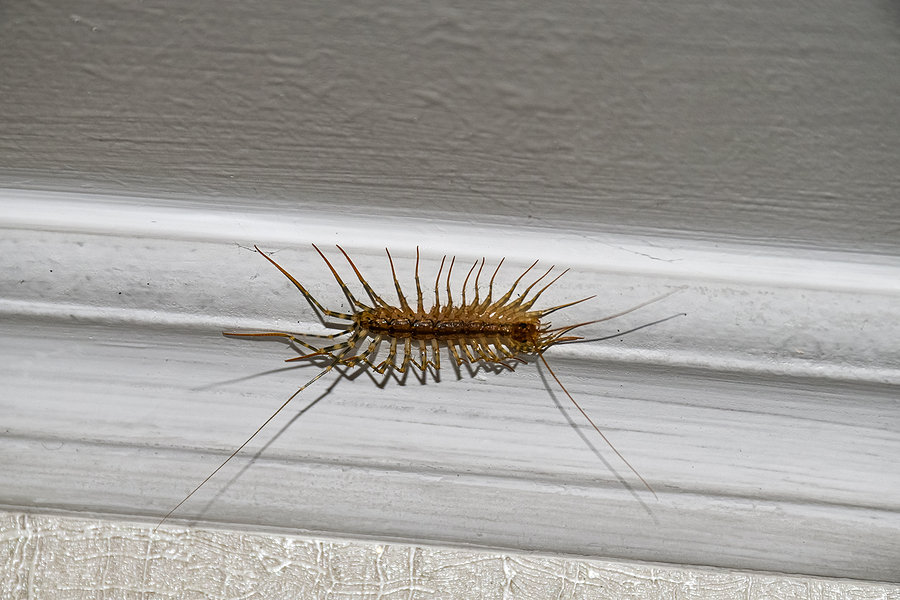READY TO GET STARTED?
REQUEST A FREE ESTIMATE
Fill out the form below or call (888) 466-7849 for a free, no-obligation estimate.

Centipedes are a common household pest. Although they range in color, the most common species are grayish-yellow with dark stripes. Most centipedes grow up to 1″ long although the largest species has been recorded at a whopping 6″ in length. Each body segment on a centipede contains a pair of legs and they can range anywhere from 15 pairs to 177 pairs. They also have hairy antennae which they can use to detect their prey. Centipedes can move fast – up to 16 inches per second!
Centipedes can be found in a variety of climates – desert, temperate, wetlands, and even forests. Like most pests, they are in search of three things: food, moisture, and warm shelter. For this reason they will often make their way into your home. Centipedes thrive in dark, cool, damp environments that are close to a food source. They can often be found under rocks, logs, and under debris. They are nocturnal, coming out at night to search for prey that includes beetles, roaches, crickets, spiders, worms, and silverfish. Unlike their millipede cousins, they do not eat wood or decaying material.
Centipedes will make their way indoors through drains, holes, cracks, gaps, and poorly sealed windows and doors. Once inside, they are commonly found inside cement walls, in boxes, under clutter, in drains, and under sinks in kitchens, bathrooms, and basements. What makes centipedes take up refuge inside your home? Centipedes are attracted to homes by three major things:
While centipedes are capable of biting and injecting venom (which they use to subdue their prey), they rarely bite humans and, when they do, their bites don’t usually puncture the skin. Centipedes are considered beneficial to have around since they help keep other pest populations in check.
Centipedes can be prevented by getting rid of the things that are attracting them in the first place. Seal any cracks, holes, and gaps in foundations and around doors and windows. Repair any leaks and get rid of standing water. Keep piles of wood and leaves away from your home. Declutter your house, garage, and basement. Keep pests under control with routine pest control service.
If you have a problem with centipedes or any other pests, contact your local pest control company for a comprehensive analysis to help identify any pest problems and recommend the most appropriate treatment options.
Why Identifying Spiders is Important for Prevention
Identifying Three Common Roaches
9 Warning Signs Of A Rodent Infestation

Although they are often confused with each other, millipedes and centipedes are two completely different pests. While both are classified as arthropods, the similarities end there. Which one is more dangerous to humans – millipede vs centipede?
Centipedes have bodies composed of many segments with one pair of legs on each segment. These long legs extend from the sides of their bodies and trail backwards behind them, making them very visible. These legs enable centipedes to move very quickly. They also have long antenna. Centipedes do have the capability to bite and are classified as predators, killing and eating their prey.
Millipedes, on the other hand, are the opposite. These arthropods have only 1 pair of legs on their first 3 body segments but then two pairs of legs for each body segment after those. Their legs are shorter and do not trail behind their bodies like centipedes do. These shorter legs make millipedes move much slower than their long-legged counterparts. Millipedes are also unable to bite. They are scavengers and do not kill prey to feed.
So which one is more dangerous? When millipedes are disturbed they will curl into a tight ball similar to a pill bug or “roly poly.” Since they are unable to bite, they emit a foul-smelling fluid that can cause irritation to the skin and eyes of humans if handled. Centipedes, on the other hand, will bite humans on occasion if they are disturbed. A centipede bite is similar to that of a bee sting, leaving behind a red bump that can swell, itch or sting. Despite these defensive mechanisms, neither millipedes nor centipedes are considered dangerous to humans or pets. Neither of these pests are known to transmit diseases or contaminate food, furniture, or plants either.
Although they aren’t considered harmful to humans, we still tend to be a little leery of their presence. You can prevent millipedes and centipedes by:
If you have a problem with millipedes or centipedes, contact your local pest control company who can help identify which of these pests you have, as well as help identify how they are getting into your home and the best method to eliminate them and prevent them from returning.
Avoiding Stinging Pests at Your Business
Controlling Birds During the Summer Months